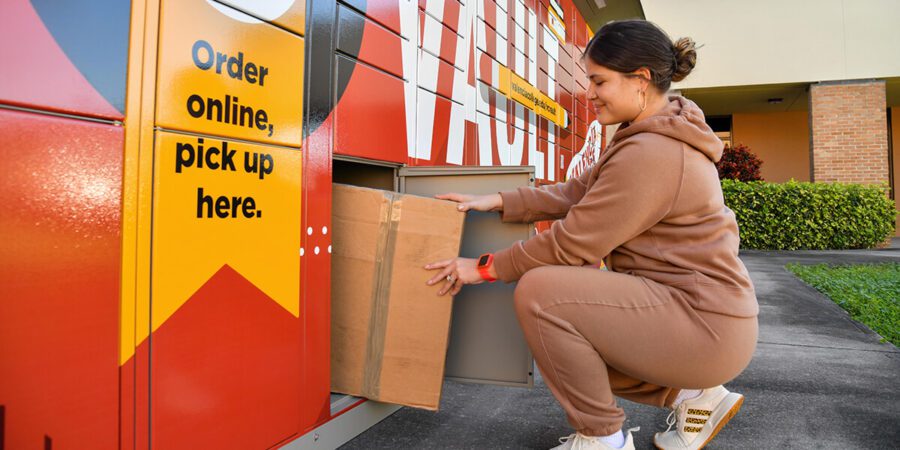
University
Boosting Library Services with Smart Lockers
Written by: Parcel Pending
4 Min Read
Published: September 20, 2024
The Changing Nature of Campus Libraries
The library is a rapidly evolving landscape on college campuses. Print resources have been demoted, staffing shortages feel urgent, budget cuts are rampant, and pandemic-era students are struggling to engage with libraries’ materials and services.
Despite these challenges, libraries aren’t going away. In fact, they are transforming to suit student needs even more effectively. For example, Purdue University found that 98% of students still spend time in the library.1 Students today now come to recharge digitally and emotionally, find a sense of community, grab a “cuppa java,” and, yes, hit the stacks for study sessions.
Here are a few ways that campus libraries are augmenting their services with smart lockers to deliver an elevated and convenient experience for students, staff, and faculty.
Benefits of Using Lockers for Library Services
When every budget dollar counts, implementing solutions that work smarter and harder is essential. Here we share how smart lockers help library staff meet both student demands (convenience) and campus administrator needs (efficiency).
More Convenient
Smart lockers reduce wait times and improve the student experience. Crucially, students can pick up loans or rentals on their schedule, including outside operating hours when the circulation desk isn’t staffed.
Valencia College in Florida, for instance, exemplifies how smart lockers can revolutionize campus operations. Initially introduced to address pandemic-related challenges for the bookstore, the college’s VC Vault locker systems now offer support beyond bookstore operations. The college’s library adopted the system as a central book distribution center, enhancing its service capabilities. By leveraging the lockers, Valencia has achieved a 94% student pick-up rate within 24 hours.
Valencia is also exploring further applications for the lockers on campus, including plans to integrate the food pantry into the VC Vault network. This expansion demonstrates the system’s versatility in addressing diverse student needs across campus. As Frankie Ortiz, Assistant Director of Auxiliary Services at Valencia College, says: “Students don’t have to work around our schedules because their time is important as well.”
More Efficient
Smart lockers also add a necessary dose of technology, speeding up operations while also reducing headcount required for fulfillment. This allows staff to reallocate their time to in-person support.
Rollins College, for instance, implemented Parcel Pending by Quadient’s Campus Hub™ solution to help manage student mail and packages, as well as the distribution of other goods and assets on campus. The institution’s locker distribution system manages everything from student mail and packages to tech equipment, library materials, campus store merchandise, food deliveries, and move-in/out supplies.
The implementation of this solution brought significant operational benefits to Rollins College, most notably enhanced efficiency – allowing the college to reduce staff hours without resorting to layoffs. Further, the improved logistics enabled the redeployment of employees to revenue-generating functions.
Delivering MORE Than Just Print Materials
As budget priorities change, more and more libraries are shifting away from print materials. A recent survey of library deans and directors revealed that when faced with potential budget cuts, print resources were among the first items they would reduce:2
- 54% would cut funding for print books
- 45% would reduce print journal subscriptions
This data suggests that physical print materials are becoming less essential in modern library collections than other resources and services. However, smart lockers adapt to changing needs and easily support the delivery of digital tools such as PCs, tablets, cords, and other media.
Quick and Easy Rental/Loan Collections with Smart Lockers
Retrieving loans or rentals from Parcel Pending smart locker solutions is easy and fast for students, staff, and faculty. Opening a locker and retrieving an item typically takes less than 10 seconds. Here’s how it works:
- Delivery: The delivery agent (in this case, library staff) scans the item or tracking barcode and places it in a locker.
- Notification: The recipient is immediately notified via email, text, or mobile app with a unique access code or barcode.
- Retrieval: Recipients use the access code or barcode to retrieve their package from the locker at their convenience.
Smart lockers can also support returns for digital tools, equipment rentals, and more.
As libraries shift their focus from traditional print materials to digital resources and community spaces, smart lockers offer a bridge between efficiency and convenience. They streamline operations, reduce staffing pressures, and cater to the modern student’s need for flexibility and 24/7 access.
Ready to deliver more for your students, staff, and faculty? Speak to a Parcel Pending by Quadient representative today.
Sources:
- Howard, Jennifer. What Brings Gen Z to the Library?. www.edsurge.com. March 11, 2024. https://www.edsurge.com/news/2024-03-11-what-brings-gen-z-to-the-library
- Hulbert, Ioana G. US Library Survey 2022: Navigating the New Normal. sr.ithaka.org. March 30, 2023. https://sr.ithaka.org/publications/us-library-survey-2022/



